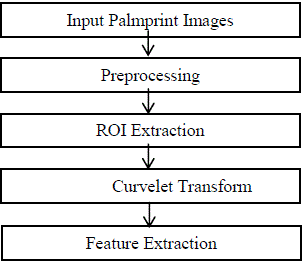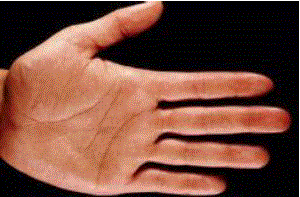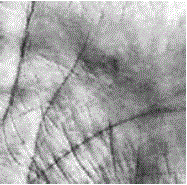Keywords
|
| Adaptive histogram equalization, Biometrics, Discrete Curvelet Transform, Palmprint |
INTRODUCTION
|
| Biometrics refers to identification/ verification of a person by the physiological or behavioural characteristic, is playing an important role in modern personal identification systems[1]. In this system, the unauthorized users are not able to display the same unique physical properties to have a positive authentication, reliability will be ensured. This is much better than the current methods of using passwords, tokens or personal identification number (PINs) at the same time provides a cost effective convenience way of having nothing to carry or remember[2]. |
| The two main categories of biometrics are „physiological? and/or „behavioural?. The physiological category includes the physical human traits such as palmprint, hand shape, eyes, veins, etc. The behavioural category includes the movement of the human, such as hand gesture, speaking style, signature etc. The measurement of these traits helps in authentication using the biometric systems. Biometrics-based personal identification systems that use physiological (e.g., fingerprint, face, iris) or behavioural (e.g., speech, handwriting) traits are being increasingly utilized in many applications, such as public security, access control and banking, to enhance the security of access systems[3]. |
| Of all the biometric authentication methods, palmprint recognition is one of the most user-friendly and reliable methods. Palmprint is concerned with the inner surface of the hand. It is unique between people, even palms of one single person?s two hands or twins palmprints[4].The damage in palm does not occur easy as other parts and also the line features of a palm are constant during one?s life span. Palmprint is preferred compared to other methods such as fingerprint or iris because it is distinctive, easily captured by low resolution devices as well as contains additional features such as principal lines[5]. With the help of palm geometry, a highly accurate biometric system can be designed. biometric information is extracted from the ridges, singular points and minutiae points[6]. they generally includes main lines which are generally clear and fine lines which are thinner and more irregular than the main lines and the ridges, lines and wrinkles are formed between the third and fifth month of pregnancy while peaks appear after birth[7]. Compared with fingerprint recognition palmprint images contain more information and needs only low resolution image capturing devices which reduces the cost of the system. Compared with iris recognition the palmprint images can be captured without intrusiveness as people might fear of adverse effects on their eyes and cost effective[8]. Hence it has become an important and rapidly developing biometrics technology over the last decade. palmprint image could provide even more information than fingerprint. can be used for fast palmprint recognition in online system. |
| The palmprint recognition system has advantages over the other physiological biometric systems. Some of the advantages are fixed line structure, low intrusiveness, low cost capturing device, low resolution imaging[9]. |
METHODOLOGY
|
| A unique flow pipeline process of this work are shown in fig.1.The methodology consists of Input Palmprint Images,Preprocessing, ROI Extraction, Discrete Curvelet Transform, Feature Extraction |
| The database has images of the size of 640 by 480 pixels. The image also contains background along with the palm image. It was observed that the lines that were detected lie in the range of 100 to 150 pixel values. For detection of the lines we have made use of a special high frequency mask since lines are high frequency areas. The data base consists of palm images of hundred persons. The images size of 256×256, 400×400, 1024×1024 was majorly used in JPEG,PNG file format[10]. |
| Preprocessing is the initial process. The palmprint images are captured with the help of standard protocols are used in this study.It uses histogram equalization and unsharp mask filtering inorder to reduce the overhead, instead of directly using the palmprint images, preprocessing needs to be done. Preprocessing is used to remove distortion, align the palmprints and to crop the region of interest[11]. |
| If X is the input image, then the histogram for that image is H(X). Based on the histogram H(X), the Probability Density Function (PDF) is defined as |
 |
| for k = 0,1,….L-1 |
| Where, L is the number of possible intensities values, nk is the number of pixels that have the gray level k appears on the input image X, N is the total number of pixels in the input Image |
| DISCRETE CURVELET TRANSFORM: |
| The preprocessed images are analysed with the help of Curvelet transform which was designed to represent edges and other singularities along curves much more efficiently than traditional transforms. curves into a collection of ridge fragments and then uses ridgelet transform to represent each fragment. Curvelet transform is the mathematical tool used to analysis curves of the images. Several features were then calculated on the curveletcoefficients[12]. The most common statistics calculated on wavelets are mean and standard deviation. Mean, standard deviation, and entropy were investigated and their power compared. Each of these first order statistics were calculated for each curvelet matrix based on each scale and orientation[13]. |
| Curvelet transform based on wrapping of Fourier samples takes a 2-D image as input in the form of a Cartesian array f[m,n] such that 0≤m<M,0≤n<N and generates a number of curvelet coefficients indexed by a scale j , an orientation l and two spatial location parameters (k1,k2) as output. To form the curvelet texture descriptor, statistical operations are applied to these coefficients. Discrete curvelet coefficients can be defined by |
 |
| Here,φj,l,k1,k2 D (m, n) each is a digital curvelet waveform. This curvelet approach implements the effective parabolic scaling law on the subbands in the frequency domain to capture curved edges within an image more effectively. Curvelets exhibit an oscillating behavior in the direction perpendicular to their orientation in frequency domain. Basically, wrapping based curvelet transform is a multiscale transform with a pyramid structure consisting of many orientations at each scale18. This pyramid structure consists of several subbands at different scales in the frequency domain. |
| MEAN: |
| The mean of a subband at scale a and orientation θ can be expressed as: |
 |
| where , M×N is the size of the image and E(a, θ ) = ΣΣ |curvelet (x ,y)| is the energy of the curvelet transformed image at scale a and orientation θ . |
| STANDARD DEVIATION: |
| The standard deviation of a subband at scale a and orientation θ can be shown as: |
| Total number of elements in the feature vector can be expressed as: |
 |
| All these elements are organized in such a way that the standard deviations remain in the first half of the feature vector and the means are inserted into the second half of the feature vector. The following explanation illustrates the structure of the feature vector. Let a curvelet feature vector of a texture image be denoted by fc and the standard deviation and mean of the curveletsubband at scale a and orientation θ are denoted by σaθ and μaθ respectively. Then the curvelet feature vector fccan be expressed as: |
 |
| where, J is the finest scale and k is the total number of subbands taken at scale a . This feature vector is then used to index the image in the feature database. |
| ENTROPY: |
| It is the measure of the variability and is zero for a constant image |
 |
| The Input palmprint image shown in fig.2 and it was cropped to obtain the ROI(Region Of Interest).This ROI Image was preprocessed using unsharp masking and adaptive histogram equalization and shown in fig. 3.It shows ridges, lines, curves, singular points and minutiae points clearly. Then, ROI of palmprint image is processed with the help of the Discrete CurveletTransform(DCvT). Curvelets exhibit an oscillating behaviour in the direction perpendicular to their orientation in frequency domain. Curvelet transform has a highly redundant dictionary which can provide sparse representation of signals that have edges along regular curve. Mean, standard deviation, entropy called image feature values are obtained and table.1.shows that extracted feature values from discrete curvelet transform of the palmprint images. |
| The extracted feature for palmprint recognition can be based on texture, lines and appearances. Each image from the data base shows different feature values each palmprint image is matched with all of thepalmprint image in the database. The different values shows that the images in the database are different persons palm. |
CONCLUSION
|
| Palmprint is regarded as one of the most unique reliable and stable personal characteristic; palmprint verification provides a powerful means to authenticate individuals for many security systems. In this work, the lines on palmprint have various resolutions. A set of curvelet transform derived features is an effective tool for palmprint technology. DCVT has provided accurate information in both the time and frequency domain on palmprint. Based on the results it shows its effectiveness and accuracy in palmprint technology. Feature extraction from the Discretecurvelet Transform is sufficient for very good texture classification. |
ACKNOWLEDGEMENT
|
| I would like to thank Dr. Ajaykumar of IIT, New Delhi for providing and help on downloading palmprint image database from IIT database. |
Tables at a glance
|
 |
| Table 1 |
|
Figures at a glance
|
 |
 |
 |
| Figure 1 |
Figure 2 |
Figure 3 |
|
References
|
- Adams wai-kin kong, David zhang “Feature- level fusion for effective palmprint authentication” canada N2L3G1.
- K.Y.Rajput, Melissa Amanna, Mankhushjagawat, Mayanksharma: “ Palmprint Recognition Using Image Processing. Technia- International Journal of computing science and communication technologies, vol.3,no.2,jan 2011(ISSN 0974-3375).
- Hengjian Li and Lianhai Wang “Palmprint Recognition using dual-tree Complex Wavelet Transform and Compressed Sensing” 2012 IEEE.
- Bob Zhang, Member, Wei Li, Pei Qing, and David Zhang, “Palm-Print Classification by Global Features” 2168-2216/ 2013 IEEE
- DakshinaRanjanKisku, Phalguni Gupta, JamunaKanta Sing “Feature Level Fusion Of Biometrics cues Human Identification With Doddgington?s Caricature”2008 IEEE.
- Anouar ben khkalifa, LamiaRzouga, NaajouaEssoukriBenAmara “Wavelet,Gabor filters and co-occurrence matrix for palmprint Verification” 2013 MECS Modern Education and Computer Science press journal.
- Dong Han,,ZhenhuaGuo, David Zhang “Multispectral Palmprint Recognition using Wavelet-based Image Fusion” 978-1-4244-2179-4/08/2008 IEEE.
- Jiansheng Chen, Yiu-Sang Moon “Using SIFT Features in Palmprint Authentication” 978-1-4244-2175-6/08/©2008 IEEE.
- TanayaMandal and Q. M. Jonathan Wu “Face Recognition using Curvelet Based PCA”. 978-1-4244-2175-6/08/©2008 IEEE.
- Satoshi Iitsuka, Kazuyuki Miyazawa and Takafumi Aoki “A Palmprint Recognition Algorithm Using Principal Component Analysis Of phase Information”978-1-4244-5654-3,2009 IEEE.
- Julio-cesar Garcia-alvarez, German castellanos, “Region of Interest Extraction Method Using Wavelets”, 2009 second international conference on communication theory. IEEE computer society journal.
- Jun-yingGan, Dang-pei Zhou “A Novel Method for Palmprint Recognition Based on Wavelet Transform” 0-7803-9737-1/06 ©2006IEEE.
- LiranShen, and Qingbo Yin “Texture Classification using Curvelet Transform” 2009 academy publisher ap-proc-cs-09cn002.
- SalimChitroub, AbdallahMeraoumia and Ahmed Bouridane “Improving Palmprint Identification by Combining Multiple Classifiers and Using Gabor Filter” 978-1-4673-1260-8/12©2012 IEEE.
- Wenxin li, David zhang, Zhuoqunxu “Image alignment based on invariant features for palmprint identification” 2003 Elsevier Science.
- Slobodan ribaric, Markanlopar, Faculty of Electrical Engineering and computing,University of Zagreb,Crotia. “ Palmprint Recognition Based on Local Haralick Features” 2012 IEEE journal.
- S. S. Kumar, R. S. Moni “Diagnosis of Liver Tumor from CT Images using Curvelet Transform.”ISSN : 0975-3397
- Yufei Han, Tieniu Tan, Zhenan sun “Palmprint Recognition Based obn Directional Features and Graph matching”springer china,2007.
- Zhen-Huaguo, Guang-minglu “palmprint Recognition using Gabor magnitude code.”978-1-4244-9/10,2010 IEEE.
|